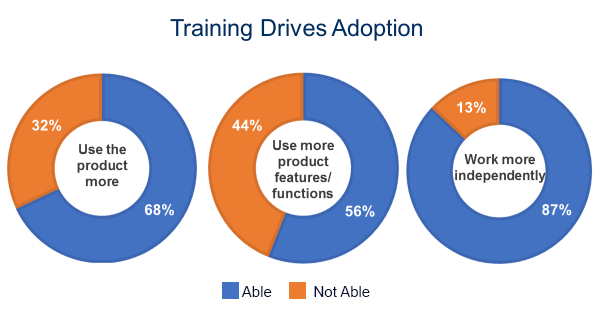In this article, we delve into the world of software training platforms, exploring how they can revolutionize your business’s learning experience. Discover the key benefits of implementing these platforms, from boosting engagement to accelerating product adoption, and learn how to create dynamic content that drives knowledge retention. We’ll also unveil the secrets of scaling efforts globally and consolidating multiple systems for seamless learning.
Key Takeaways
- Boost engagement and knowledge retention through hands-on, interactive training.
- Create dynamic content for continuous learning and adaptability.
- Scale training effortlessly across the globe with online platforms.
- Consolidate multiple systems into one comprehensive training solution.
- Accelerate product adoption through practical, real-world training scenarios.
Table of Contents
- Introduction
- Boost Engagement and Knowledge Retention
- Create Dynamic Content Quickly
- Scale Training Effortlessly to the Ends of the Earth
- Consolidate Multiple Systems
- Accelerate Product Adoption
- Analytics Driven Insights for Continuous Improvement
- Product-led Growth Potential
- Empower Customer Success
- Conclusion
- Frequently Asked Questions
Introduction
In today’s fast paced digital landscape, empowering users to quickly grasp software functionalities and unlock its full potential is crucial for business success. Research has shown that effective software training can lead to 68% increase in product usage and a 56% rise in utilizing more product features. On the flipside, insufficient training can become a significant barrier to adopting new workplace technologies, leaving nearly half of employees feeling unprepared to embrace change.
What happens if you don’t provide any (or enough) training? Almost half of employees in an Oracle survey said that insufficient training was a barrier to adopting new workplace technologies.

Boost Engagement and Knowledge Retention
Are you delivering training using PowerPoint slides? We hope not, as, learners only remember an average of 4 slides from a 20-slide, standalone, text-only PowerPoint presentation.
A platform tailored for software training should allow learners to learn by doing on your software – this helps boost knowledge retention. Learners can carry out hands-on exercises in controlled virtual training environments that allow them to use and immerse themselves in the software with no risk to the company’s infrastructure.
As we’ve already mentioned, learners use the product more— and use more of its features— when they’ve had proper training. It’s also more fun to learn by doing using hands-on exercises, which will encourage learners to want to complete the training.
Create Dynamic Content Quickly
Continuous learning and micro-learning are also key to knowledge retention. You shouldn’t just deliver training all at once when users first start using your product – you need to let them learn at their own pace, and in bitesize chunks.
This is especially true when it comes to software, which is constantly evolving with new features or product updates. A platform optimized for software training allows you to quickly build and deliver more engaging, immersive, and dynamic content.
Scale Training Effortlessly to the Ends of the Earth
With an online training software, you don’t have to send your instructors to different offices around the world to train learners in person. Instead, you can deliver hands-on training to anyone, anytime and anywhere, from any device or platform. Learners don’t have to be locked in a classroom all day long, and instructors can teach from wherever they are based. Users can also access everything they need in one place.
Your instructors can also deliver training to more learners at the same time as there are no constraints on classroom size, and they can deliver the same session as many times as necessary, with no extra cost.

Consolidate Multiple Systems
Some companies have one solution to train their employees and another to train their suppliers, partners, customers, and other external users. With the right online training software, you can consolidate these solutions into one system to provide a seamless learning experience, as well as create segments to deliver training to different types of users who have different needs. As you only have one platform, it’s easier to ensure the branding is consistent, and provide a user experience that reflects your company values.
You can also integrate your existing solutions with your software training platform. For example, if you want to train salespeople on your new software, you might want to get real-world customer examples from your CRM or sales management system and pull these into your software training platform.
Accelerate Product Adoption
In any business, you’ll find a range of people with different technical abilities. If your training isn’t up to scratch, the time it takes for learners to get up to speed will increase. Some may end up avoiding using the product altogether if they don’t understand it.
As software training platforms deliver hands-on training in real-world scenarios, learners can get to use the software themselves, instead of watching a video or seeing someone else demo the product. This leads to accelerated product adoption, and means you can onboard employees quicker, as well as get your customers up and running faster.
Analytics Driven Insights for Continuous Improvement
A software training platform equipped with robust analytics provides valuable insights into learner engagement, progress, and performance. Data-driven feedback allows you to identify areas where learners may be struggling and fine-tune your training content accordingly. This continuous improvement ensures that learners receive the most relevant and effective training to maximize software adoption and utilization.
Appsembler Tahoe and Virtual Labs offer comprehensive analytics tools that empower you to understand learner behavior and training effectiveness better. This knowledge allows you to optimize your training programs continually, resulting in higher engagement and successful software onboarding.
Product-led Growth Potential
Incorporating a software training platform aligns perfectly with the principles of Product-Led Growth (PLG). By enabling users to experience your software’s value through hands-on training, you create a compelling and intuitive user journey. PLG focuses on providing a delightful user experience from the moment users sign up, and an integrated training platform can enhance that experience.
Empower Customer Success
In the realm of product marketing, customer success is paramount. A software training platform not only ensures that your customers can effectively use your product but also empowers them to achieve their desired outcomes. As customers become proficient with your software, they can fully leverage its features, driving higher satisfaction and long-term loyalty.
Conclusion
In today’s fast-paced digital landscape, software training is not just an option but a strategic necessity for businesses seeking growth and success. By investing in a software training platform like Appsembler Tahoe and Virtual Labs, you can boost engagement, accelerate product adoption, and consolidate training efforts while embracing the principles of Product-Led Growth and Product Marketing.
Don’t let your software’s potential go untapped—empower your users, whether they are employees, customers, or partners, with the knowledge and skills they need to thrive in your software ecosystem. Reach out to our team today to discover how Appsembler Tahoe and Virtual Labs can revolutionize your software training approach and lead your business towards a brighter, more prosperous future.
Frequently Asked Questions
By enabling users to experience software value through hands-on training, these platforms enhance the user journey, aligning with PLG strategies.
Yes, the platforms support integration with existing solutions, enabling businesses to enhance training content with real-world examples from their CRM or sales management system.
Insufficient training can become a significant barrier to adopting new workplace technologies, leaving nearly half of employees feeling unprepared to embrace change.
Effective software training can lead to a 68% increase in product usage and a 56% rise in utilizing more product features, driving overall business growth.
Learners get to use the software themselves, leading to accelerated product adoption, quicker employee onboarding, and faster customer onboarding.



